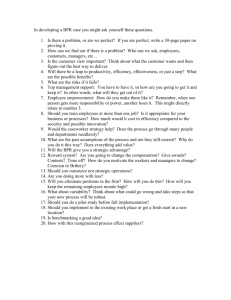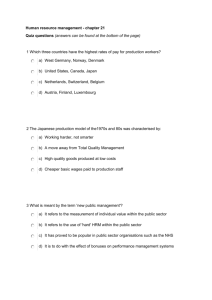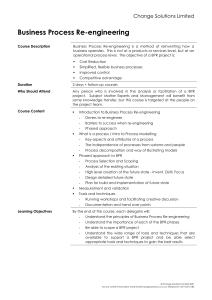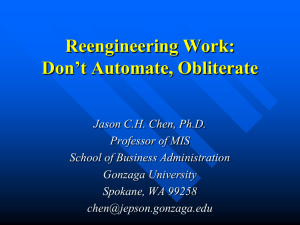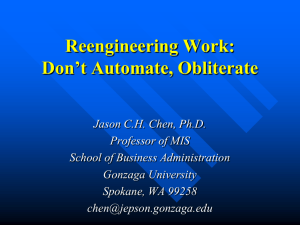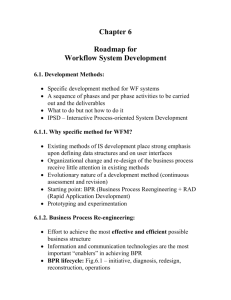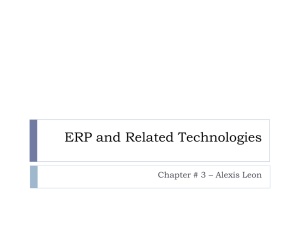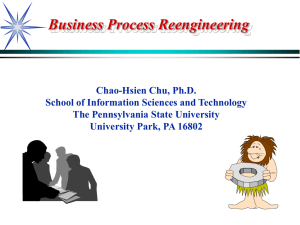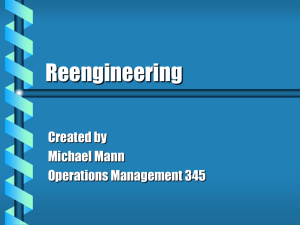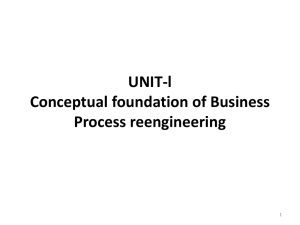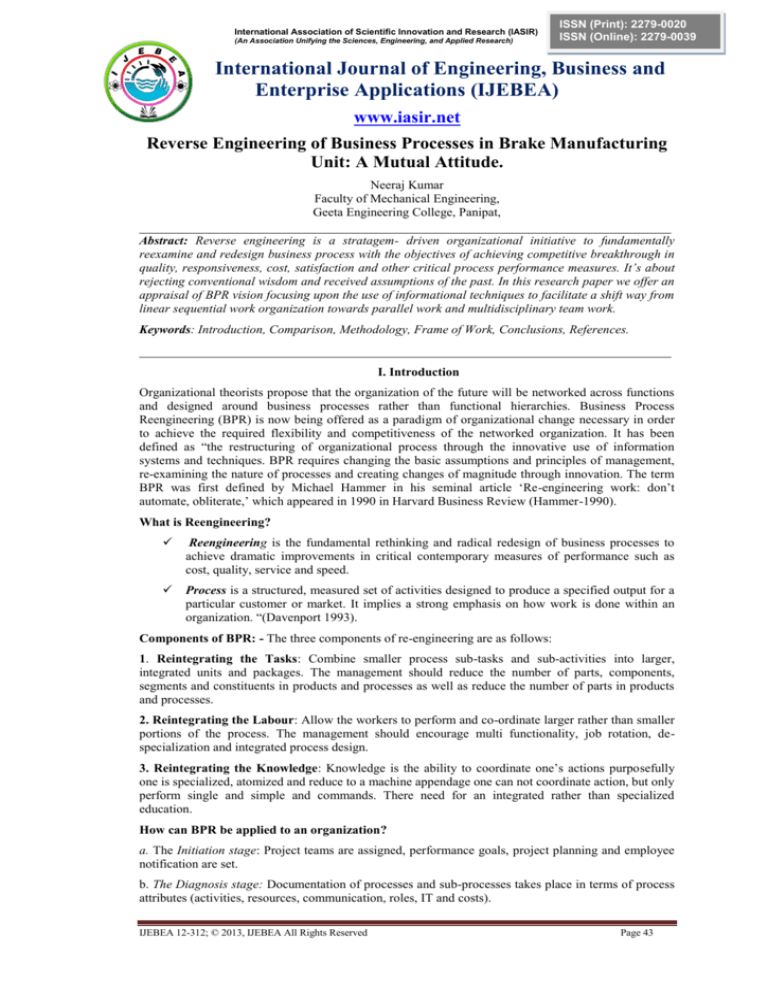
International Association of Scientific Innovation and Research (IASIR)
(An Association Unifying the Sciences, Engineering, and Applied Research)
ISSN (Print): 2279-0020
ISSN (Online): 2279-0039
International Journal of Engineering, Business and
Enterprise Applications (IJEBEA)
www.iasir.net
Reverse Engineering of Business Processes in Brake Manufacturing
Unit: A Mutual Attitude.
Neeraj Kumar
Faculty of Mechanical Engineering,
Geeta Engineering College, Panipat,
___________________________________________________________________________
Abstract: Reverse engineering is a stratagem- driven organizational initiative to fundamentally
reexamine and redesign business process with the objectives of achieving competitive breakthrough in
quality, responsiveness, cost, satisfaction and other critical process performance measures. It’s about
rejecting conventional wisdom and received assumptions of the past. In this research paper we offer an
appraisal of BPR vision focusing upon the use of informational techniques to facilitate a shift way from
linear sequential work organization towards parallel work and multidisciplinary team work.
Keywords: Introduction, Comparison, Methodology, Frame of Work, Conclusions, References.
___________________________________________________________________________
I. Introduction
Organizational theorists propose that the organization of the future will be networked across functions
and designed around business processes rather than functional hierarchies. Business Process
Reengineering (BPR) is now being offered as a paradigm of organizational change necessary in order
to achieve the required flexibility and competitiveness of the networked organization. It has been
defined as “the restructuring of organizational process through the innovative use of information
systems and techniques. BPR requires changing the basic assumptions and principles of management,
re-examining the nature of processes and creating changes of magnitude through innovation. The term
BPR was first defined by Michael Hammer in his seminal article ‘Re-engineering work: don’t
automate, obliterate,’ which appeared in 1990 in Harvard Business Review (Hammer-1990).
What is Reengineering?
Reengineering is the fundamental rethinking and radical redesign of business processes to
achieve dramatic improvements in critical contemporary measures of performance such as
cost, quality, service and speed.
Process is a structured, measured set of activities designed to produce a specified output for a
particular customer or market. It implies a strong emphasis on how work is done within an
organization. “(Davenport 1993).
Components of BPR: - The three components of re-engineering are as follows:
1. Reintegrating the Tasks: Combine smaller process sub-tasks and sub-activities into larger,
integrated units and packages. The management should reduce the number of parts, components,
segments and constituents in products and processes as well as reduce the number of parts in products
and processes.
2. Reintegrating the Labour: Allow the workers to perform and co-ordinate larger rather than smaller
portions of the process. The management should encourage multi functionality, job rotation, despecialization and integrated process design.
3. Reintegrating the Knowledge: Knowledge is the ability to coordinate one’s actions purposefully
one is specialized, atomized and reduce to a machine appendage one can not coordinate action, but only
perform single and simple and commands. There need for an integrated rather than specialized
education.
How can BPR be applied to an organization?
a. The Initiation stage: Project teams are assigned, performance goals, project planning and employee
notification are set.
b. The Diagnosis stage: Documentation of processes and sub-processes takes place in terms of process
attributes (activities, resources, communication, roles, IT and costs).
IJEBEA 12-312; © 2013, IJEBEA All Rights Reserved
Page 43
Neeraj, International Journal of Engineering, Business and Enterprise Applications, 3(1), Dec., 2012-February, 2013, pp. 43-47
c. The Redesign stage: New process design is
developed by devising process design alternatives and
through brainstorming and creativity techniques.
d. The Reconstruction stage: Management technique
changes occur to ensure smooth migration to the new
process responsibilities and human resource roles.
e. The Evaluation stage: The new process is monitored
to determine if goals are met and examine total quality
programs.
How to reengineer: - In resuming, the whole process
of BPR in order to achieve the expected results is based
on key steps-principles which include redesign, retool,
and re orchestrate. Each step-principle embodies the
actions and resources as presented in the table below.
REDESIGN
RETOOL
REORCHESTRATE
Simplify
Network
Synchronize
Standardize
Intranets
Processes
Empowering
Extranets
IT
Groupware
Workflows
Human resources
II Comparison in the World of Work:Conventional Approach
BPR
Functional departments
Process Teams
Division of labor
Empowered employees
Controlled people
Multidimensional work
Training of employees
Education of employees
Compensation for skill and time spent
Compensation for results
Advancement based on ability
Advancement based on performance
Managers supervise and control
Managers coach and advice
Protective organizational culture
Productive organizational structure
Hierarchical organizational structure
Horizontal (flat) structure
Executives as scorekeepers
Executives as leaders
Separation of duties and functions
Cross-functional teams
Mass production
Mass customization
III. BPR Methodologies
Cobra Methodology
Talwar Methodology
Identifying the Opportunity
Programme Initiation
Analysis of an Existing Process
Design and Implementation
Process Re-design
Implementation of the Change
Performance Monitoring
IJEBEA 12-312; © 2013, IJEBEA All Rights Reserved
Page 44
Neeraj, International Journal of Engineering, Business and Enterprise Applications, 3(1), Dec., 2012-February, 2013, pp. 43-47
Rapid BPR Methodology implemented in RBI:Stage 1: Preparation: - Appropriately begins with the development of an executive consensus on
break though business goals and objectives that signify the raison of this Re-engineering project. This
stage also clearly establishes the essential linkage between the break through business goals and the
Re-engineering process performance parameters regarding schedule, risk and organizational change.
This stage also brings together the Re-engineering team and brings from the initial change management
plan.
Stage 2: Identification: Develops a customer-oriented model of business, identifies strategic valueadded processes and maps organizations, resources and volumes to specific processes and priorities and
recommends specific processes as the highest impact Re-engineering targets.
Stage 3: Vision: Looks for break through opportunities in the processes, analysis and structures them
as “vision” of radical change.
Stage 4: Solution: It’s actually divided into two nearly parallel sub-stages, one to develop the technical
design to implement the visions and the “social” design which organizes and structures the human
resources that will staff the Re-engineering process.
Stage 5: Transformations: Realizes the process vision, launching, pilot and full production versions to
the new processes. Thus, this model provides more or less a linear process of undertaking reengineering exercise.
Company Profile: Roulunds Braking (India) Pvt. Ltd. is leading manufacturer of Disc Brakes Pads in
India, is known for Global quality Asbestos free passenger vehicles Disc brake pads. Started its
production recently in 1998 under name Hilton Roulunds (India) later changed to Roulunds Braking
(India) and have state of the art manufacturing facility at Sonepat in state of Haryana. The company is
continuously supplying its friction material to highly competitive European Market / USA Market or
we can say that company is 100% export oriented unit. The company products are well accepted in the
global market because of its quality, competitiveness and delivery commitment. The company is a
wholly owned subsidiary of MAT (Midwest-Air Technologies), based at USA, MAT is Investment
Company. The company total manpower is 1200 and turnover is 220 Billion P.A.
Process Flow Diagram of RBI
BACKPLATE INCOMING
POWDER MIX
CURING & POWDER COATING
HYDRAULIC PRESSING
COMPRESSION & MOULDING
GRINDING &FINISHING
SHIM FITMENT, PRESSING & RIVETTING
IJEBEA 12-312; © 2013, IJEBEA All Rights Reserved
Page 45
Neeraj, International Journal of Engineering, Business and Enterprise Applications, 3(1), Dec., 2012-February, 2013, pp. 43-47
IV. Frame of work:
S.N. Complaint
Process
Counter Measure
1
SPOTS
PRESSING
FOREIGN
MATERIAL
ENTRAPPING; CLEANING
UNDER LAYER CREATION
REGULARLY
2
POROSITY
PRESSING
LESS WEIGHT OF
IMPROPER TEMP.
3
CRACKS
PRESSING
GROOVENOT
HANDLING
4
COUNTER
THICKNESS
POWDER
MIXING
IMPROPER BALANCE OF
OPERATOR NEGLIGENCE
5
UNCLEAR
GAP POWDER
BETEEN LAYER MIXING
6
GREEN
PADS/
CURING
RUSTED PADS
7
LOW THICKNESS GRINDING
TRAINING
TO
IMPROPER RECIPY SELECTION; LACK OF PROVIDE
KNOWLEDGE
ABOUT
PROCES OPERATORS ABOUT RECIPY AND
PERAMETERS SELECTION
PERAMETERS
8
SETUP FAILURE GRINDING
PROVIDE
ALL
NECESSARY
OPERATOR NEGLIGANCE; LESS SKILLED
INSTRUCTIONS TO OPERATORS
OPERATOR
BEFORE OPERATION
9
GAP CREATION
SHIM
BETWEEN PLATE
FITMENT
AND SHIM
ENSURE PROPER CLEANING OF
IMPROPER CLEANING OF PADS; POOR PADS AFTER EACH STROKE AND
QUALITY MATERIAL USED
USE
GOOD
QUALITY
OF
MATERIAL
10
BACK
FAILURE
O/S; U/S OF TOOL; IMPROPER TOOL ENSURE PHYSICALLY CHECKING
SELECTION
OF TOOL AFTER EACH STROKE
PLATE
ASSEMBLY
Improvement
POWDER
CLEAR;
OF
PUNCHES
PROPER SETTING OF BALANCE;
MIX; ADEQUATE KNOWLEDGE OF
MACHINE
PERAMETERS
TO
OPERATORS
IMPROPER ENSURE PROPER CLEANING OF
GROOVE BEFORE OPERATION
ENSURE PROPER WORKING OF
POWDER, PHYSICAL BALANCE, EMPLOY
SINGLE MAN FOR BALANCING
ONLY
IMPROPER MIXING OF POWDER
PRESENCE OF POISTURE AT
SURFACE; IMPROPER CURING
ENSURE
PROPER
PROPORTIONATE OF POWDER
PLATE ENSURE MOISTURE FREE PLATE
BEFORE CURING; CHECKING OF
PROCESS PERAMETERS
V. Results & Conclusion:
A passionate customer focus, superior process design and a strong motivated leadership are
vital ingredient to the procedure for the success of any business organization. BPR is the way
that every organization should adopt to attain their fundamentals for success. Neither it
provide a sensation cure on a tray nor a painless quick fix, rather it promotes arduous hard
work and activate the people involved to not only the alteration what they do but targets at
varying their basic way of thinking itself. In this paper I have attempted in evolving a
structured approach to reengineering.
References:
1. Feldmann Clarence.G, (1998),The Practical Guide to Business Process Reengineering using IDEF0.,
Dorset
House Publishing, New York.
2 Chouinard Marc, 2005, “Integration of reverse logistics activities within a supply chain information
system”, Computers Industry, Vol.56, pp.105-124.
IJEBEA 12-312; © 2013, IJEBEA All Rights Reserved
Page 46
Neeraj, International Journal of Engineering, Business and Enterprise Applications, 3(1), Dec., 2012-February, 2013, pp. 43-47
3. Gonzalez-Torre, 2004, “Environmental and reverse logistics polices in European bottling and
packaging firms”, International Journal Production Economics, Vol.88, pp.95-104.
4. Grover Varun, 1994, “Exploring the Seven of Information Technology Enable Business Process Reengineering”, IEEE transactions on Engineering Management, Vol.41, No.3, pp.276-283.
5. Manganelli, Raymond.L., Klein, Mark.M., (1994), The Reengineering Handbook: A Step-by-Step
Guide to Business Transformation., American Management Association, New York.
6. Subramanian Muthu, Larry Whitman, and S. Hossein Cheraghi (1999) the 4th Annual International
Conference on Industrial Engineering Theory, Applications and Practice November 17-20, 1999, San
Antonio, Texas, USA
7. Mayer, Richard.J., Dewitte, Paula.S., (1998), Delivering Results: Evolving BPR from art to
engineering.
8. Kumar Sanjay, 2007, “Optimization of Material”, Industrial Engineering Journal, Vol.36, No.8,
pp.32-34.
9. Jeremy F. Shapiro, 2004, “Challenges of strategic supply chain planning and modeling”, Computers
and Chemical Engineering, Vol.28, pp. 855–861.
10. Korpela Jukka, 2001, “An analytic approach to supply chain development”, International Journal
Production Economics, Vol.71, pp.145-155.
11. Grover Varun, 1994, “Exploring the Seven of Information Technology Enable Business Process
Re-engineering”, IEEE transactions on Engineering Management, Vol.41, No.3, pp.276-283.
12.“Going Backwards: Reverse Logistics Trends and Practice” by |Dr dale S. Rogers and Dr Ronald s.
Tribben- Lembke ( University of Nevada Reno, Centre for Logistic Management)
IJEBEA 12-312; © 2013, IJEBEA All Rights Reserved
Page 47

